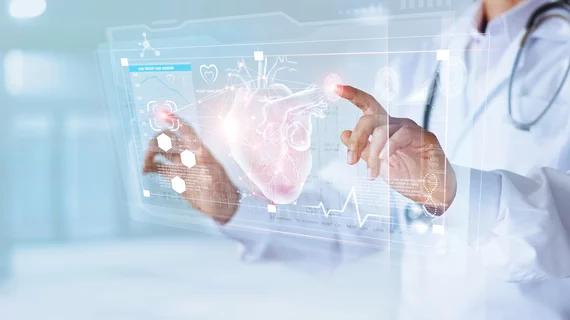Automated valve tracking reduces time, variability in 4D flow MRI
Automated cardiac valve tracking halved the analysis time and variability in blood-flow quantification with four-dimensional (4D) flow MRI, researchers reported in Radiology. The algorithm may help clinicians more efficiently assess the severity of congenital and valvular heart disease, they said.
“Time-resolved, three-dimensional, three-directional velocity-encoded MRI, also termed four-dimensional (4D) flow MRI, allows for direct quantification of blood flow volumes through all four valves derived from one acquisition and shows superior accuracy over conventional two-dimensional (2D) phase-contrast MRI, in particular for quantification of regurgitant volumes and severity of cardiac shunts,” wrote Vivian P. Kamphuis, MD, and colleagues from Leiden University Medical Center in the Netherlands.
However, clinicians seldom employ this technique because manual tracking of each cardiac phase is a time-consuming process with considerable variation between operators.
But with an automated algorithm and 4D MRI software, Kamphuis et al. found blood-flow analysis could be cut from 25 minutes to 14 minutes. The automated valve tracking was also associated with half of the variability in net forward volume (NFV) assessments across all four valves (4.9 percent versus 9.8 percent).
The study included 114 patients, including 33 with acquired heart disease and 81 with congenital heart disease. In addition, 46 healthy volunteers underwent 4D MRI.
“Since this was a retrospective study, the findings did not change patient treatment at this moment,” the authors noted. “However, if diagnosis would have been based only on MRI results, automated valve tracking would have reclassified six patients with at least mild-to-moderate valve regurgitation at the pulmonary valve (six of 114, 5%), 10 patients with at least mild-to-moderate mitral valve regurgitation (10 of 114, 9%), and 12 patients with at least mild-to-moderate tricuspid valve regurgitation (12 of 114, 11%). This may have had a significant impact on clinical decision making regarding follow-up regimen.”
Also, automated valve tracking reclassified two patients into a category for severe pulmonary valve regurgitation, which may have impacted a recommendation for surgery, Kamphuis and colleagues pointed out.
“Automated cardiac valve tracking reduces analysis time and improves reliability of valvular flow quantification by 4D flow MRI in patients with acquired or congenital heart disease and in healthy volunteers, possibly allowing for a wider application of this imaging technique in the clinical setting,” they wrote.
In a related editorial, Christopher J. Francois, MD, said this work has the biggest implications for patients with tricuspid and mitral valve disease, because 2D MRI is sufficiently accurate for assessing flow through the pulmonary and aortic valves but less so for the other valves. He predicted automated algorithms will lead to the increased use of cardiac MRI for evaluating patients with mitral or tricuspid regurgitation, but said even more efficient approaches may be on the horizon.
“Machine learning has improved the reproducibility and accuracy of automatic segmentation algorithms, including in cardiac MRI,” wrote Francois, with the department of radiology at the University of Wisconsin. “In the future, machine learning approaches might be compared with the current method for automatic valve tracking and may further reduce analysis times for these complex patient conditions.”

